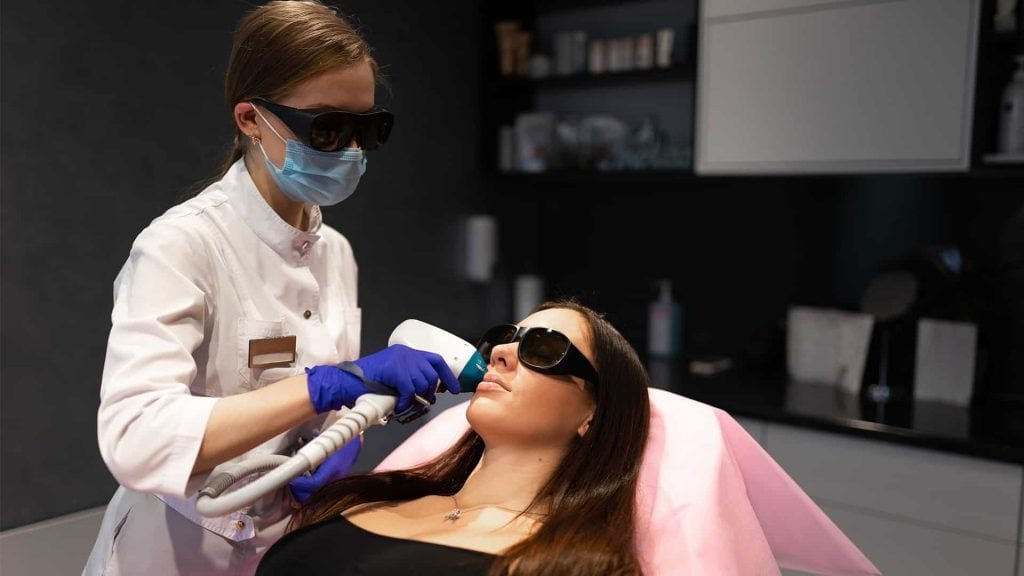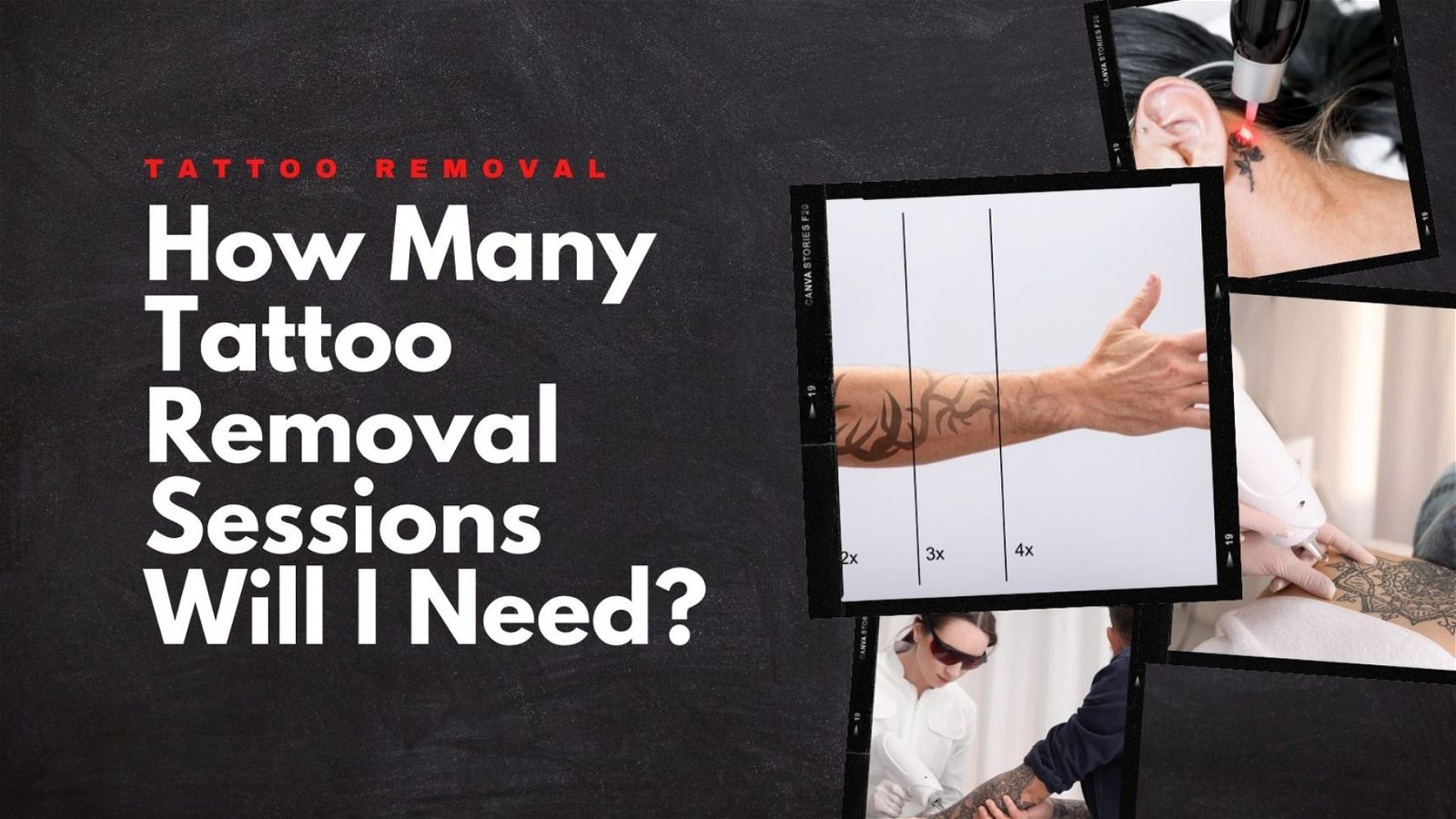You want to remove your tattoo, but you’re not sure how many sessions it will take.
The number of sessions required for a successful removal varies from person to person and depends on several important factors. So how can you estimate how many sessions you’ll need?
Not knowing how many tattoo removal sessions you need can result in not having enough finances and leaving a tattoo half removed (looks worse), not understanding the commitment (think about time in between sessions).
We’ve created this helpful guide to understand how many removal sessions you need to go through to remove your tattoo entirely.
How Many Sessions Will I Need?
As mentioned earlier, you will likely need between 6 to 10 sessions to remove your tattoo. However, this number may also vary depending on the individual.
Also, to make sure your skin heals appropriately, each session should occur no sooner than 6 weeks apart. So, if you have a large tattoo that needs to be removed, expect a longer removal process.
It is important to consult with a dermatologist to estimate the number of sessions you will need. They will be able to consider all of the factors that affect tattoo removal and give you a tailored estimate.
Tattoo Removal Methods
One of the main factors determining how many sessions are needed is the tattoo removal method used. The most common methods are:

Laser Tattoo Removal
Laser tattoo removal is the most common method, and it uses a laser to break down the ink pigments in the tattooed area. The number of sessions required varies depending on the tattoo’s size, colour, and age.
There are four main types of lasers used for tattoo removal:
- Q-Switched Nd YAG Laser
This laser is the most used option for tattoo removal. It operates at 1064nm and works well in removing black and dark blue inks.
- Q-Switched Ruby Laser
It operates at 694nm and is best for removing red ink pigments.
- Q-Switched Alexandrite Laser
It operates at 755 nm and is the best for removing green, black, and blue tattoos.
- Picosecond Laser
The newest type of laser uses shorter pulse lengths and works best on black, green, and blue inks but can also be used for red, orange, and purple.
Dermabrasion
Dermabrasion is a surgical procedure that uses a wire brush or diamond wheel to remove the top layer of skin. The number of sessions for this method is difficult to predict because certain pigments, like fluorescent colours, are hard to remove. With dermabrasion, the sessions are typically performed within 2 to 4 weeks.
Surgical Excision
Surgical excision is a surgical procedure that removes the entire tattoo. It’s often used on large tattoos. There are no recurring sessions with surgical excision because the whole tattoo is removed in one procedure.
Factors Affecting Tattoo Removal Sessions
The number of sessions required to remove a tattoo varies depending on the following factors:
Type of Ink Used
Some inks are more challenging to remove than others. Black ink is the easiest to remove, while red and yellow inks are the most difficult. This is because black and other darker inks absorb the laser best.
Tattoo Size
The tattoo’s size also affects how many sessions are needed for removal. Small tattoos can be removed in as few as six to eight sessions, while larger tattoos may require ten or more sessions.
Age of Tattoo
The age of the tattoo also determines how many sessions are necessary for removal. An old tattoo requires fewer sessions than a new one because the ink pigments have already faded.
Location of Tattoo
Tattoos close to the eyes, face, or hands respond to treatment quickly because they have larger blood vessels. Therefore, pigments are easily absorbed by the body.
But this doesn’t mean that face tattoos are easy to remove. Complications may arise because of the skin type and the proximity to the eyes. That’s why tattoo removal experts are more careful and prefer longer sessions than usual when dealing with these locations.
On the other hand, tattoos found on the feet, ankles, and buttocks may take a few more sessions to remove.
Skin Tone
Darker skin tones require longer sessions to remove tattoos than lighter skin tones. This is because the laser energy is absorbed more by dark pigments in the skin. If you want to know your skin type, you can use the Fitzpatrick scale as a reference.
How Does Laser Tattoo Removal Work?
Laser tattoo removal is a safe and effective way to remove tattoos. The tattoo’s ink pigments absorb the laser energy, breaking down the ink particles. The body then eliminates the broken-down ink through the natural filtering process of the liver and kidneys.
What to Expect Before a Tattoo Removal Session
Before your first tattoo removal session, you will need to schedule a consultation with the doctor. This is an opportunity for them to assess your tattoo and determine how many sessions you will need.
During the consultation, they will also go over the risks and benefits of laser tattoo removal and answer any questions you may have.
You will also be required to undergo a skin test to determine your skin’s sensitivity to the laser. This simple procedure involves applying a small amount of laser treatment to a patch of skin on your arm. If you experience any redness or swelling, you may not be able to have the treatment.
It would help if you also avoided sun exposure before your session, as this can increase the risk of skin damage.
What to Expect During a Tattoo Removal Session
The tattoo removal session will last about 15 minutes. During this time, the doctor will inject lidocaine (local anaesthetic) on the area and then use a laser to remove the ink from your tattoo.
You may feel a slight burning sensation during the treatment. However, most people do not find the feeling to be very painful.
You will likely experience some redness and swelling after the treatment. This is normal and will go away within a few days.
It is crucial to keep the treated area clean and dry. It would be best to avoid sun exposure until the swelling goes down.
Possible Risks of Laser Tattoo Removal
Although laser tattoo removal is a safe and effective procedure, some risks are involved. These include:
Skin irritation
Skin irritation is a common risk associated with laser tattoo removal. This is usually caused by the laser energy being absorbed by the skin. It can cause redness, swelling, and blistering.
Redness
Redness around the treated area is temporary and will disappear within a few days. However, in some cases, they may last a bit longer.
Skin discolouration
Skin discolouration is another common risk associated with laser tattoo removal. This is caused by the ink being broken down into smaller pieces. The ink can sometimes settle in the skin and cause permanent discolouration.
Infection
Although infection is rare, it is a potential risk associated with any surgery. Consult your doctor if you experience any redness or drainage from the treated area.
Scarring
Scarring is another potential risk associated with laser tattoo removal. It is vital to follow post-treatment instructions carefully to minimise the risk of scarring.
If you experience any of these symptoms, please immediately consult your doctor.
Final Thoughts
Laser tattoo removal is a safe and effective procedure to remove unwanted tattoos. Although the number of sessions you need may vary depending on the individual, most people require between 7 and 10 sessions. This also means to keep in mind the cost of tattoo removal as each session will be charged.
It is important to consult with a dermatologist to estimate the number of sessions you will need. They will consider all of the factors that affect tattoo removal and give you a tailored estimate.
By following post-treatment instructions carefully, you can minimise the risk of scarring. If you experience any symptoms that concern you, please consult your doctor immediately.
Sources:
- Laser Tattoo Removal Sessions
https://www.ncbi.nlm.nih.gov/pmc/articles/PMC4411606/
- Fitzpatrick’s Scale
https://jamanetwork.com/journals/jamadermatology/fullarticle/1737180





